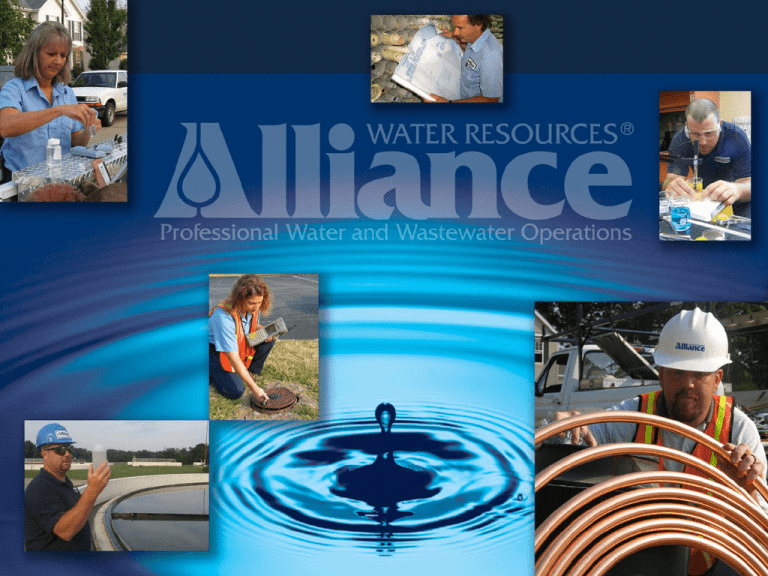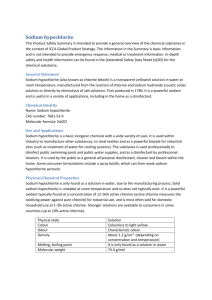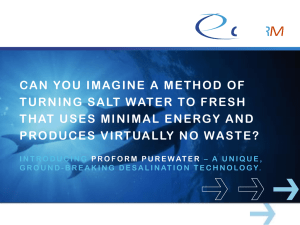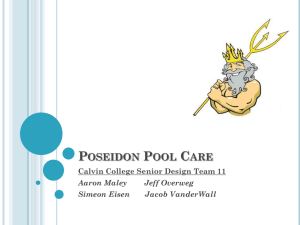Replacing Gas Chlorine with Onsite Sodium Hypochlorite Generation
advertisement

Replacing Gas Chlorine with Onsite Sodium Hypochlorite Generation Tim Geraghty, P.E. Division Manager Alliance Water Resources, Inc. Replacing Gas Chlorine with Onsite Sodium Hypochlorite Generation Goal: help other utility managers decide if changing disinfectants would be worth considering What made us consider a change What options we considered Costs & benefits Design Construction Background Most water treatment facilities use chlorine as their primary disinfectant Chlorine use became widespread in the early 1900’s Chlorine has a proven track record Chlorine gas is a highly hazardous chemical Background St. Charles County, MO Water Treatment Plant has successfully used chlorine gas in 1-ton containers as a disinfectant since 1941 Plant capacity 8 MGD average 22 MGD peak Water Treatment Plant, St. Charles County, MO 1940 2013 They don’t build ‘em like they used to Water Treatment Plant 1940 2013 Not much has changed Background 2005 - Water District purchased the treatment plant 2012 - Water District completed an overall WTP assessment Reviewed existing condition of the plant facilities & equipment Reviewed plant processes Developed and prioritized a capital improvement plan Background Results of the plant assessment Electrical/efficiency upgrades $1.4M Filter upgrades $2.3M Booster pump station replacement $4.0M Replacement of the gas chlorine feed system $2.5M Lime, ammonia and fluoride system improvements $0.9M Total $9.7M Why consider changing from chlorine gas? Need to update existing chemical processes, controls and equipment due to age Safety Employees People in the surrounding community Environment Why consider changing from chlorine gas? 1997 – one ton container split 25 miles away in Kirkwood, Missouri 2012 – one ton container leaking 10 miles away in Chesterfield, Missouri Why consider changing from chlorine gas? 2002 – leaking 1” hose connected to 90-ton railcar 50 miles away in Festus, Missouri 48,000 pounds released - 63 people injured Pictures from US Chemical Safety & Hazard Investigation Board Report, 2003 Why change? Federal OSHA Safety Regulations (TOSHA requirements may be more stringent) EMPLOYEES OSHA Process Safety Management (29 CFR 1910.119) Respirators – fit testing, medical baselines and periodic evaluations Hot Work Confined Space Contractor Safety & Record Keeping Coordination with LEPC Management of Change Chlorine Institute Pamphlet 65 for PPE Chlorine Institute Pamphlet 155 for water and wastewater operators Training Record keeping, record keeping, record keeping Why change? Federal Safety Regulations - EPA PEOPLE IN THE SURROUNDING COMMUNITY US EPA Risk Management (in section 112(r) of the Clean Air Act) Worst case release scenario Alternative release scenarios Offsite consequence analysis Estimating offsite receptors Hazard reviews Operating procedures Compliance Audits Mechanical integrity Employee participation Coordinating with LEPC Communication with the Public Regular re-submittals Why change? Protect the Environment Water Plant Missouri Conservation Department Wildlife Area US Army Training Area University Research Area (added political pressure from regulators) To decide if a disinfectant change was worthwhile, we reviewed our goals and other disinfectants Review of Alternatives Water Quality Considerations Requirements for disinfection Groundwater Rule 4-log removal of viruses Chlorine contact time Effects of chlorination on pH Distribution system bacteria regrowth potential THM’s/HAA’s Nitrate formation Chlorite formation Review of Alternatives Selection Criteria Criteria Safety Life Cycle Costs Capital O&M labor Power Chemicals Waste treatment/hauling Chemical & power cost stability Chemical strength stability Chemical availability Review of Alternatives Selection Criteria Criteria Need for additional treatment Level of automation Permitting issues Space requirements Operational flexibility, familiarity & simplicity Equipment reliability Review of Alternatives Gas chlorine Ozone Ultraviolet (UV) Light Chlorine dioxide Hypochlorite Calcium hypochlorite Sodium hypochlorite Onsite hypochlorite generation Bulk deliveries Combinations of the above Review of Alternatives Gas Chlorine in 1-ton containers (current practice) Advantages – low capital and operating cost, simple operation, low maintenance Disadvantages – hazardous and toxic chemical, potential of leaks & high level of regulation Review of Alternatives Gas Chlorine in 150-pound cylinders Advantages – low capital and operating cost, simple operation, low maintenance Disadvantages – hazardous and toxic chemical, potential of leaks & high level of regulation Switching to smaller cylinders would reduce the quantity released during a major leak, but more changeovers & handling would be required Review of Alternatives Ozone Expensive Additional disinfectant needed for maintaining residual in distribution Often used to eliminate a specific contaminant Ultraviolet (UV) Light Additional disinfectant needed for maintaining residual in distribution Often used to eliminate a specific contaminant Review of Alternatives Chlorine dioxide Strong disinfectant Stops THM formation May require additional treatment for chlorite Often used for pre-treatment – not as the lone disinfectant Review of Alternatives Bulk Sodium Hypochlorite (typically 12.5% solution) Advantages – Low capital cost, generally safer than chlorine gas Disadvantages – High operating cost, degradation, corrosive health hazard Review of Alternatives Generated Sodium Hypochlorite (0.8% solution) Advantages – no storage of highly hazardous chemicals, consistent product concentration Disadvantages – High capital cost, hydrogen gas byproduct, short product storage time Review of Alternatives Process Schematic Bulk hypochlorite components Onsite hypochlorite generation components Hazardous to Environment, Users, and Community Chlorine Gas NFPA Rating Health = 4 Flammability = 0 Bulk Sodium Hypochlorite (11 - 15%) 0 4 NFPA Rating 0 OX Instability = 0 Oxidizer Health = Lethal Short Term Exposure = Burns, Chest Pain, Emotional Disturbances, Lung Damage, Death Physical Hazards = Containers may rupture or explode. Health = 2 Flammability = 0 0 2 1 OX Instability = 1 Oxidizer Health = Intense or continued exposure could cause temporary incapacitation or residual injury. Instability = Can become unstable at elevated temperatures and pressures. Environmentally Benign 0.45% Generated FAC or 0.8% Generated FAC NFPA Rating Health = 1 Flammability = 0 NaCl (SALT) NFPA Rating 0 1 0 Health = 1 Flammability = 0 0 1 0 Instability = 0 Instability = 0 Health = Exposure may cause mild irritation Health = Exposure may cause mild irritation Instability = Normally stable, even under fire conditions. Instability = Normally stable, even under fire conditions. Review of Alternatives Comparison Capital Cost Annual O&M Hazard Potential* Chlorine Gas (add $900,000 $50,000 highly hazardous gas Ozone High High limited UV Bulk Sodium Hypochlorite Generated Sodium Hypochlorite High High low $650,000 $160,000 highly corrosive liquid $1,900,000 $100,000 hydrogen gas by-product scrubber & other controls) Of these alternatives, only gas chlorine requires PSM & RMP programs Review of Alternatives Cost savings due to eliminating PSM training and administration 60 training hours annually for operators & maintenance staff 200 hours annually for contractor training 100 hours annually for administration per year training reports, maintenance reports, PSM Manual updates, PSM and RMP annual SOP certifications, periodic resubmission of PSM and RMP documentation, internal compliance audits, testing of chlorine sensors, … $10,000 - $15,000 per year Review of Alternatives UV and Ozone were ruled out - high costs + additional need for residual disinfectant For the two hypochlorite alternatives, onsite generation preferred because of lower O&M Chosen Alternative: Onsite Generation of Sodium Hypochlorite because of reduced safety concerns; estimated additional cost of treated water less than $0.04 per 1,000 gallons (<1% of user rate) Design Considerations First step – choose a hypochlorite generator manufacturer Equipment varies by manufacturer Major considerations Safety considerations Ease of operation/number of components Equipment footprint Life cycle costs Availability Design Considerations Choosing a hypochlorite generator manufacturer The cost of materials varies by manufacturer but one pound of chlorine is generated by roughly: 15 gallons soft water (at 15-40 gpm and about 60 psi) 3 pounds salt 2 kilowatt-hours Design Considerations – Site Visits Designers and operators visited several installations of various manufacturers Design Considerations Efficiency & Complexity Indoor Equipment (generators, blowers, power and control panels) Room arrangement/ available space HVAC requirements & equipment heat loss Outdoor Equipment (tanks & accessories) Sunshades Design Considerations Sodium Hypochlorite Storage Tanks Storage time Degradation (esp. for 12.5%) Sodium Hypochlorite Metering Pumps Based on each feed point’s chlorine demand Sized for both 12.5% and 0.8% solution Design Considerations Standby Options Standby generator Provisions for bulk delivery Plant Shutdown (generally available at this location September through May) Capital Costs Equipment Bids ChlorTec (two 750 ppd units)$ 536,500 MIOX (three 500 ppd units) $ 572,980 PSI (two 800 ppd units) $ 619,500 Construction Bids (includes equipment) Engineer’s final estimate Low of 5 bids: KCI Construction $2,041,000 $2,213,500 Chosen Alternative - MIOX Simplicity / fewest components Smallest footprint / able to fit most equipment in the existing building Design Considerations for Chosen Alternative System Control Panel Inputs Water hardness Brine tank level Storage Tank Level System Components Brine pump Generators/rectifiers Hydrogen dilution blowers Sodium hypochlorite storage tank level Chosen Alternative - MIOX Construction Construction Sequence Site work Install outdoor hypochlorite tanks Install new process piping and metering pumps Place bulk hypochlorite (12.5%) system in operation Remove existing gas chlorine piping and equipment Install hypochlorite generators in the space vacated by the gas chlorine system Construction Schedule and current progress Site work completed (relocated storm & sanitary sewers) Bulk tanks, piping, water softeners, pumps and dilution panel installed Construction Schedule and current progress SOP’s written and operators trained in bulk chemical feed process Bulk chemical (12.5%) and tanks being put in operation next week Remaining work to be completed by July 2013 Remove existing gas chlorination system Install hypochlorite generation and other equipment inside the building and start-up Key Points Ultimately, the Water District Board decided that increasing the level of safety was worth the additional capital and O&M costs Our chosen disinfection alternative was not the lowest cost alternative The chosen manufacturer’s equipment was not the lowest cost alternative Involving the operators in the decisionmaking was critical and strongly influenced the decision The operators (and probably their spouses) can’t wait for the workplace to be safer For More Information Tim Geraghty, P.E. Division Manager Alliance Water Resources 100 Water Drive O’Fallon, MO 63368 636-561-3737 x101 tgeraghty@alliancewater.com www.alliancewater.com Special Thanks to Black & Veatch and Parkson Disinfection for technical information they provided for the presentation











